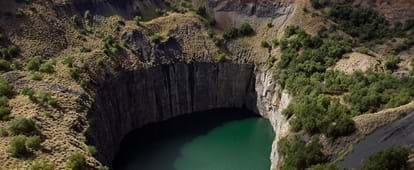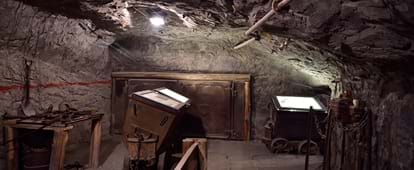By creating an account, I agree to the
Terms of service and Privacy policy
Choose your country and language:
Africa
Americas
Asia Pacific
Europe
MMining in South Africa has been a contentious issue since 15-year-old Erasmus Stephanus Jacobs discovered South Africa’s first diamond, the Eureka, in Hopetown in 1867. It kickstarted what historians call the Mineral Revolution, which made few European opportunists wealthy beyond measure, and saw hundreds of thousands of men leaving their homes to become fulltime mineworkers.
Today, the mining industry remains one of the biggest contributors to the country’s economy with an estimated worth of R20.3 trillion (US$2.5 trillion). It is the world’s fifth largest mining sector in terms of gross domestic product (GDP), contributing eight percent to South Africa’s GDP. Do not let the numbers deter you from the realities of mining in the past. It was, and to some degree remains a dangerous job.
The mineworker’s plight was captured wonderfully by founding member of the African National Congress, Sol Plaatjie, in 1914. “Two hundred thousand subterranean heroes who, by day and by night, for a mere pittance lay down their lives to the familiar ‘fall of rock’ and who, at deep levels, ranging from 1 000 to 3 000 feet in the bowels of the earth, sacrifice their lungs to the rock dust which develops miners' phthisis and pneumonia.”
IIt was with these dangers in mind that miners have demanded higher wages throughout the industry’s 150-year history. As a result, mining has been marred by violence, with the Marikana Massacre of 2012 being the most recent occurrence where police killed 34 workers and injured 78.
Such events are rooted in a strike led by the African Mine Workers’ Union in August 1946. Miners of the Witwatersrand were demanding higher pay: an extra 10 shillings a day. The strike went on for a week despite what South African History Online describes as “the most savage police terror”. Officially, the police and army attacked the unarmed workers, wounding 1 248 and killing nine.
The strike had “profound repercussions which are felt until this day”, said the history portal.
Most major cities around the world were built on or near a body of water as a matter of survival. But Johannesburg, built on the arid Highveld, spawned from a lust for gold. The story behind gold’s discovery is still disputed. Jan Gerrit Bantjes and the Struben brothers unearthed gold on separate occasions in 1884. However, according to South African History Online, these were minor reefs and credit for the discovery of the main reef on Langlaagte Farm went to Australian George Harrison in July 1886. Johannesburg’s large gold deposits that ran for miles underground ensured the little mining town mushroomed into a leviathan.
Before the discovery, there were about 600 white farmers in the Witwatersrand region, which was considered well-populated at the time. Within a year of gold findings, the area had some 7 000 people with 3 000 living in Johannesburg. By 1895, just nine years after the Langlaagte find, Johannesburg was home to some 102 000 people. To date the Witwatersrand Basin, the largest gold resource in the world, has produced more than two billion ounces of gold.

SSouth Africa is also rich in platinum, manganese and coal, and large industries have grown from these minerals. However, none of them had induced the “dangerous madness” like diamonds did, which attracted hundreds of people in ox wagons and mule carts who wanted to make it rich.
Some even travelled by foot from as far as Cape Town, a more than 1 000 kilometre journey across the Karoo, to reach the diamond fields of Kimberley and the Transvaal. While prospecting, these miners endured poor diets and horrible living conditions. A stench hung over the tented settlements, approach roads were lined with the carcasses of pack animals and open trenches served as public toilets. Only a few became rich. One of these men was British tycoon Cecil John Rhodes who founded De Beers, which came to dominate the market and is still synonymous with diamonds today.

FFast forward to the late 20th century, and South African diamonds are still sought after, with an estimated R16-billion worth of the stones sold locally and internationally per year.
Diamond miners were memorialised in the Diggers Fountain, which you can find in Kimberley. Installed at the Ernest Oppenheimer Memorial Gardens in 1959, Herman Wald’s bronze sculpture portrays five men holding up a diamond sieve.
Mining in South Africa continues to transform the country to this day. Currently, the industry is mostly run by white executives overseeing a huge, low-skilled and cheap black workforce but industry and government are trying to change that by increasing black ownership.
By the end of 2011, South Africa’s mining industry was the largest contributor to economic transformation, with broad-based black economic empowerment deals worth R150-billion completed.

AAbout the author
Shamin Chibba has 13 years of writing experience, including three years as an editor. He has written in numerous formats, from long-form features for Al Jazeera Magazine and Brand South Africa.com to adaptations of classic tales for graphic novels. He also founded Seer Media, which provided news and information for NGOs in the Eastern Cape. When not writing, he can be found squirming painfully while trying to perfect his kung fu horse-stance. You can find his portfolio at Edge of Mystery.
Related articles

